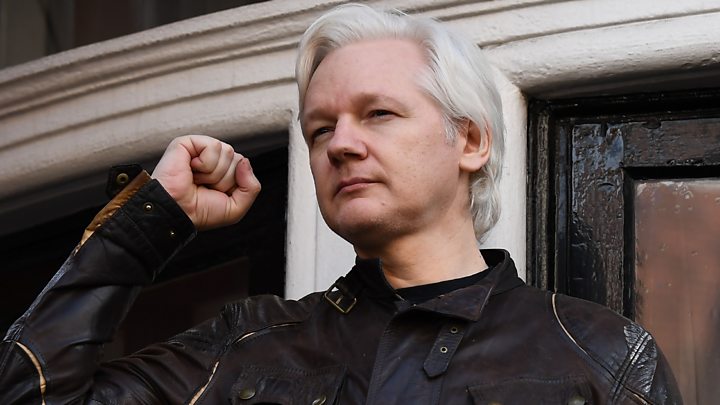Home » Latin America »
Why Ecuador ended Assange’s stay in embassy
Ecuador has said its decision to end Julian Assange’s asylum in its embassy in London was taken after a long deterioration in relations – accusing him of improper behaviour, interference in the affairs of other countries and spying.
From skateboarding to insulting staff
For seven years, Julian Assange took refuge in a small office that was converted into a bedroom in Ecuador’s embassy in an upmarket neighbourhood of central London, where he lived with his cat, James. It had a bed, sun lamp, computer, kitchenette, shower and treadmill.
During his time there, the 47-year-old WikiLeaks co-founder welcomed guests including Lady Gaga and Pamela Anderson and, from a tiny balcony, addressed supporters and held news conferences.
But relations between him and Ecuador’s government worsened under President Lenín Moreno, who took office in 2017. This became evident last year when Assange was given a set of house rules, including paying for internet use, food and laundry, taking better care of his cat and keeping the bathroom clean.
Patience was already running thin and, explaining the withdrawal of Assange’s protection on Twitter, President Moreno accused him of “repeated violations to international conventions and daily-life protocols”. He said Ecuador had “reached its limit” on Assange’s “discourteous and aggressive behaviour”.
More details emerged later, when Foreign Minister José Valencia told Congress that Assange had been using a mobile phone not registered with the embassy, repeatedly insulted the mission’s workers, reportedly calling them US spies, and damaged the facilities by riding his skateboard and playing football, despite being told not to do so.
Cleaning staff, Mr Valencia said, had described “improper hygienic conduct” throughout Assange’s stay, an issue that a lawyer had attributed to “stomach problems”. One unnamed senior Ecuadorean official told AP news agency that other issues included “weeks without a shower” and a “dental problem born of poor hygiene”.
Interior Minister María Paula Romo then complained that Assange had been allowed to do things like “put faeces on the walls of the embassy and other behaviours of that nature” although Vaughan Smith, a friend who visited Assange last week, told Reuters that he believed this claim was false.
“Julian has been under stress but seemed in a balanced frame of mind every time I have seen him. It doesn’t seem in character,” Mr Smith said.
Mr Valencia added that the decision to remove his protection was taken to prevent a further deterioration of Assange’s health, without giving details.
Spying suspicions
President Moreno, who ordered Assange to cut back his online activity soon after taking office, also said Assange had “violated the norm of not intervening in the internal affairs of other states”, most recently in January 2019 when WikiLeaks released documents from the Vatican.
He said that, and other cases, confirmed suspicions that Assange was still linked to WikiLeaks. The president also accused Assange of having installed forbidden “electronic and distortion equipment” and of accessing the embassy’s security files.
There was also the suspicion that WikiLeaks was linked to an anonymous website that said the president’s brother had created an offshore company – the material included private pictures of President Moreno and his family.
Mr Valencia added that, in January, Assange told Ecuador’s ambassador he had installed panic buttons that he would activate if he considered his life to be in danger.
It was not clear what he meant by that but British authorities who arrested him on Thursday were careful to prevent Assange from returning to his room during the operation, according to AP.
The whistle-blower also allegedly played loud music and deliberately blocked security cameras.
Why did Assange end up at the embassy?
The Australian national had been in the Ecuadorean embassy in London since 2012, after seeking asylum there to avoid extradition to Sweden on a rape allegation, which he has always denied. He was given protection by then President Rafael Correa, a strong advocate of WikiLeaks.
What about his cat?
It is unclear what has happened to James. His own Instagram account has not offered any clues, with the last picture posted in 2017.
Reports suggest he was given to a shelter by the Ecuadorean embassy some time ago while Italian newspaper La Repubblica said last year Assange had himself freed him.
Source: Read Full Article



